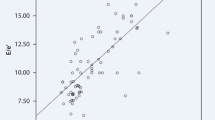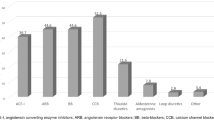Abstract
Introduction
This study aimed to investigate the relationship between homocysteine (Hcy) and blood pressure variability (BPV) and the relationship between Hcy and left ventricular hypertrophy (LVH) in 102 patients with essential hypertension.
Methods
The 102 patients were divided into the Hcy < 10 μmol/L group (n = 47) and the Hcy ≥ 10 μmol/L group (n = 55) according to Hcy concentration. The differences between Hcy and BPV and Hcy and LVH were compared between the two groups. Finally, the correlations between Hcy and BPV and between Hcy and LVH were analyzed.
Results
The results showed that there were significant differences between Hcy and BPV and between Hcy and LVH in the two groups. Hcy correlated positively with the coefficient of variation in nighttime diastolic blood pressure and night systolic blood pressure standard deviation (nDBPSD), with correlation coefficients of 0.331 and 0.303 (P < 0.001). At the same time, Hcy correlated positively with interventricular septal thickness and left ventricular posterior wall thickness, which were indicators of LVH, with correlation coefficients of 0.350 and 0.352 (P < 0.001).
Conclusions
There was a correlation between Hcy and BPV and between Hcy and LVH. Attention should also be paid to blood Hcy and BPV for patients with essential hypertension.


Similar content being viewed by others
References
Kuang ZM, Wang Y, Feng SJ, Jiang L, Cheng WL. Association between plasma homocysteine and microalbuminuria in untreated patients with essential hypertension: a case-control study. Kidney Blood Press Res. 2017;42(6):1303–11.
Skeete J, Dipette DJ. Relationship between homocysteine and hypertension: new data add to the debate. J Clin Hypertens (Greenwich). 2017;19(11):1171–2.
Fang X, Wang Z, Wang C, et al. Cardiovascular and cognitive health study in middle-aged and elderly residents of Beijing(CCHS-Beijing): design and rationale. Neuroepidemiology. 2016;46(3):182–90.
Li T, Zhu J, Fang Q, et al. Association of H-type hypertension with stroke severity and prognosis. Biomed Res Int. 2018;2018:8725908.
Liu J, Quan J, Li Y, Wu Y, Yang L. Blood homocysteine levels could predict major adverse cardiac events in patients with acute coronary syndrome: a STROBE-compliant observational study. Medicine (Baltimore). 2018;97(40):e12626.
Xu B, Kong X, Xu R, et al. Homocysteine and all-cause mortality in hypertensive adults without pre-existing cardiovascular conditions: effect modification by MTHFR C677T polymorphism. Medicine (Baltimore). 2017;96(8):e5862.
Yun L, Xu R, Li G. Homocysteine and the C677T gene polymorphism of its key metabolic enzyme MTHFR are risk factors of early renal damage in hypertension in a Chinese han population. Medicine (Baltimore). 2015;94(52):e2389.
Sera F, Jin Z, Russo C, et al. Relationship of office and ambulatory blood pressure with left ventricular global longitudinal strain. Am J Hypertens. 2016;29(11):1261–7.
Bendall JK, Douglas G, Mcneill E, Channon KM, Crabtree MJ. Tetrahydrobiopterin in cardiovascular health and disease. Antioxid Redox Signal. 2014;20(18):3040–77.
Han L, Wu Q, Wang C, et al. Homocysteine, ischemic stroke, and coronary heart disease in hypertensive patients: a population-based. Prospect Cohort Study. Stroke. 2015;46(7):1777–86.
Howard VJ, Sides EG, Newman GC, et al. Changes in plasma homocyst(e)ine in the acute phase after stroke. Stroke. 2002;33(2):473–8.
Zhou F, Zhou L, Guo T. Plasma proteomics reveals coagulation, inflammation, and metabolic shifts in H-type hypertension patients with and without acute ischemic stroke. Oncotarget. 2017;8(59):100384–95.
Zhong F, Zhuang L, Wang Y, Ma Y. Homocysteine levels and risk of essential hypertension: a meta-analysis of published epidemiological studies. Clin Exp Hypertens. 2017;39(2):160–7.
Miao CY, Yuan WJ, Su DF. Comparative study of sinoaortic denervated rats and spontaneously hypertensive rats. Am J Hypertens. 2003;16(7):585–91.
Bakris GL, Sarafidis PA, Weir MR, et al. Renal outcomes with different fixed-dose combination therapies in patients with hypertension at high risk for cardiovascular events (ACCOMPLISH): a prespecified secondary analysis of a randomised controlled trial. Lancet. 2010;375(9721):1173–81.
Turner JR, Viera AJ, Shimbo D. Ambulatory blood pressure monitoring in clinical practice: a review. Am J Med. 2015;128(1):14–20.
Rimpela JM, Porsti IH, Jula A, et al. Genome-wide association study of nocturnal blood pressure dipping in hypertensive patients. BMC Med Genet. 2018;19(1):110.
Wang C, Deng WJ, Gong WY. High prevalence of isolated nocturnal hypertension in Chinese patients with chronic kidney disease. J Am Heart Assoc. 2015;4(6):e002025.
Wald NJ, Watt HC, Law MR, Weir DG, McPartlin J, Scott JM. Homocysteine and ischemic heart disease: results of a prospective study with implications regarding prevention. Arch Intern Med. 1998;158(8):862–7.
Xiao W, Bai Y, Ye P, et al. Plasma homocysteine is associated with aortic arterial stiffness but not wave reflection in Chinese hypertensive subjects. PLoS One. 2014;9(1):e85938.
Brozovich FV, Nicholson CJ, Degen CV, Gao YZ, Aggarwal M, Morgan KG. Mechanisms of vascular smooth muscle contraction and the basis for pharmacologic treatment of smooth muscle disorders. Pharmacol Rev. 2016;68(2):476–532.
Wang C, Zhang J, Liu X, et al. Reversed dipper blood-pressure pattern is closely related to severe renal and cardiovascular damage in patients with chronic kidney disease. PLoS One. 2013;8(2):e55419.
Jing L, Nevius CD, Friday CM, et al. Ambulatory systolic blood pressure and obesity are independently associated with left ventricular hypertrophic remodeling in children. J Cardiovasc Magn Reson. 2017;19(1):86.
Miller A, Mujumdar V, Palmer L, Bower JD, Tyagi SC. Reversal of endocardial endothelial dysfunction by folic acid in homocysteinemic hypertensive rats. Am J Hypertens. 2002;15(2 Pt 1):157–63.
Mao X, Xing X, Xu R, et al. Folic Acid and vitamins D and B12 correlate with homocysteine in Chinese patients with type-2 diabetes mellitus, hypertension, or cardiovascular disease. Medicine (Baltimore). 2016;95(6):e2652.
Wang WW, Wang XS, Zhang ZR, He JC, Xie CL. A meta-analysis of folic acid in combination with anti-hypertension drugs in patients with hypertension and hyperhomocysteinemia. Front Pharmacol. 2017;8:585.
Acknowledgements
We thank all participants of the study.
Funding
The study was supported by Yulin Science and Technology Research Project (No: 161034), Guangxi Science and Technology Plan Project (No: 1598011-2) and PRIME China Post-Single Group Study (XP China SAS, No: 12-396). The Rapid Service Fee was funded by the authors.
Authorship
All named authors meet the International Committee of Medical Journal Editors (ICMJE) criteria for authorship for this article, take responsibility for the integrity of the work as a whole, and have given their approval for this version to be published.
Authorship Contributions
Bei-You Lin and Ping Li contributed equally to this work.
Disclosures
Bei-You Lin, Ping Li, Xiao-Dan Wu, Hao Li, and Zhi-Yu Zeng have nothing to disclose.
Compliance with Ethics Guidelines
The scheme adopted in this study was based on the principles of the Helsinki Declaration and approved by the Ethics Committee of the Yulin First Hospital. All participants provided written consent to participate in the study.
Data Availability
The datasets generated and/or analyzed during the current study are available from the corresponding author on reasonable request.
Author information
Authors and Affiliations
Corresponding author
Additional information
Enhanced Digital Features
To view enhanced digital features for this article go to https://doi.org/10.6084/m9.figshare.10272503.
Rights and permissions
About this article
Cite this article
Lin, BY., Li, P., Wu, XD. et al. The Relationship Between Homocysteine, Blood Pressure Variability, and Left Ventricular Hypertrophy in Patients with Essential Hypertension: An Observational Study. Adv Ther 37, 381–389 (2020). https://doi.org/10.1007/s12325-019-01154-7
Received:
Published:
Issue Date:
DOI: https://doi.org/10.1007/s12325-019-01154-7




